Formulating Strategic Plans and Techniques for Effective Market Entry
VerifiedAdded on 2019/12/03
|15
|3776
|29
Essay
AI Summary
The provided content discusses the application of Porter's Five Forces model and stakeholder analysis in developing a market entry strategy for the mentioned company. The company aims to create an environment where it can make a significant profit and revenue in the future, ensuring its long-term sustainability. This summary highlights the importance of understanding the competitive landscape and stakeholders' perspectives when formulating a strategic plan.
Contribute Materials
Your contribution can guide someone’s learning journey. Share your
documents today.
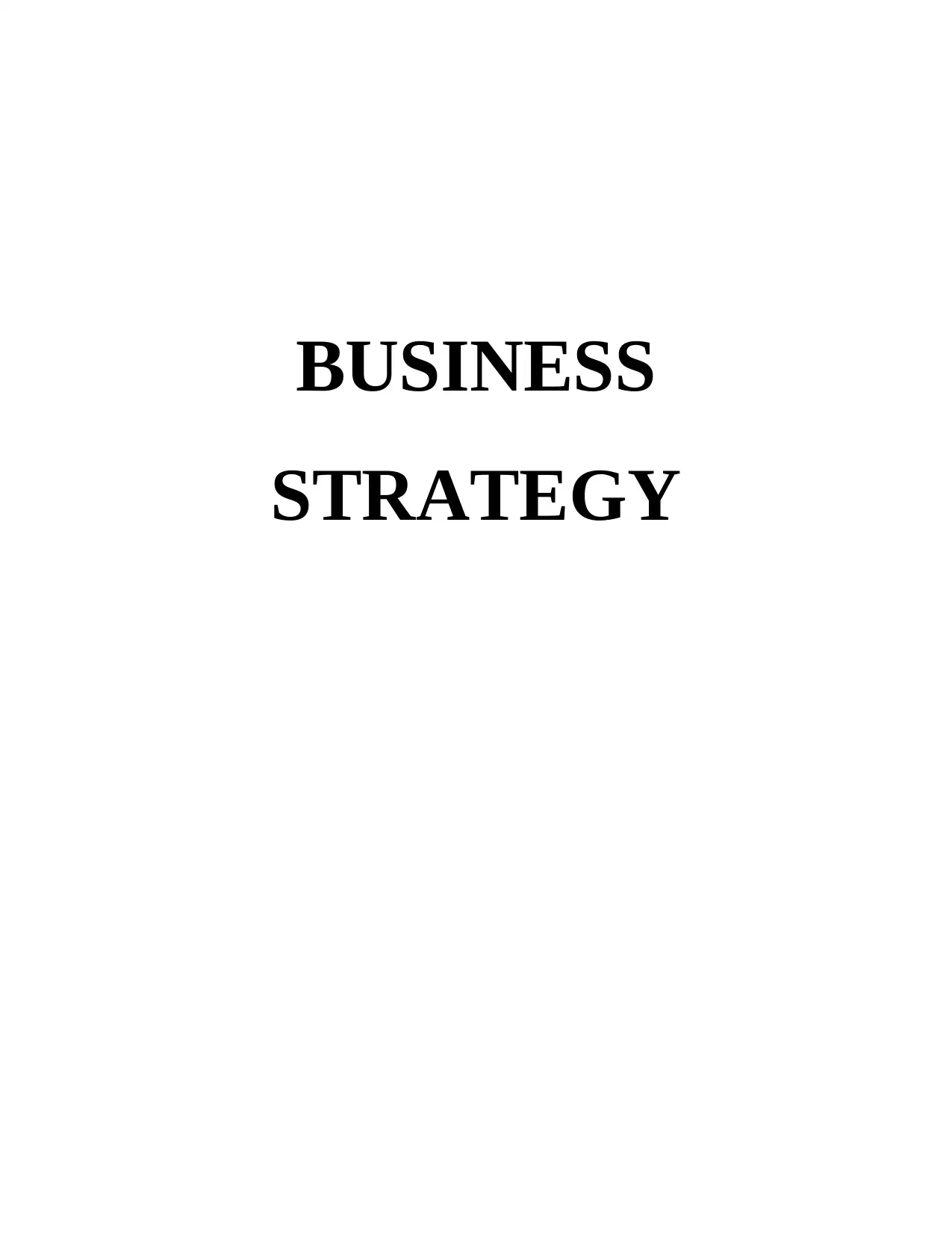
BUSINESS
STRATEGY
STRATEGY
Secure Best Marks with AI Grader
Need help grading? Try our AI Grader for instant feedback on your assignments.
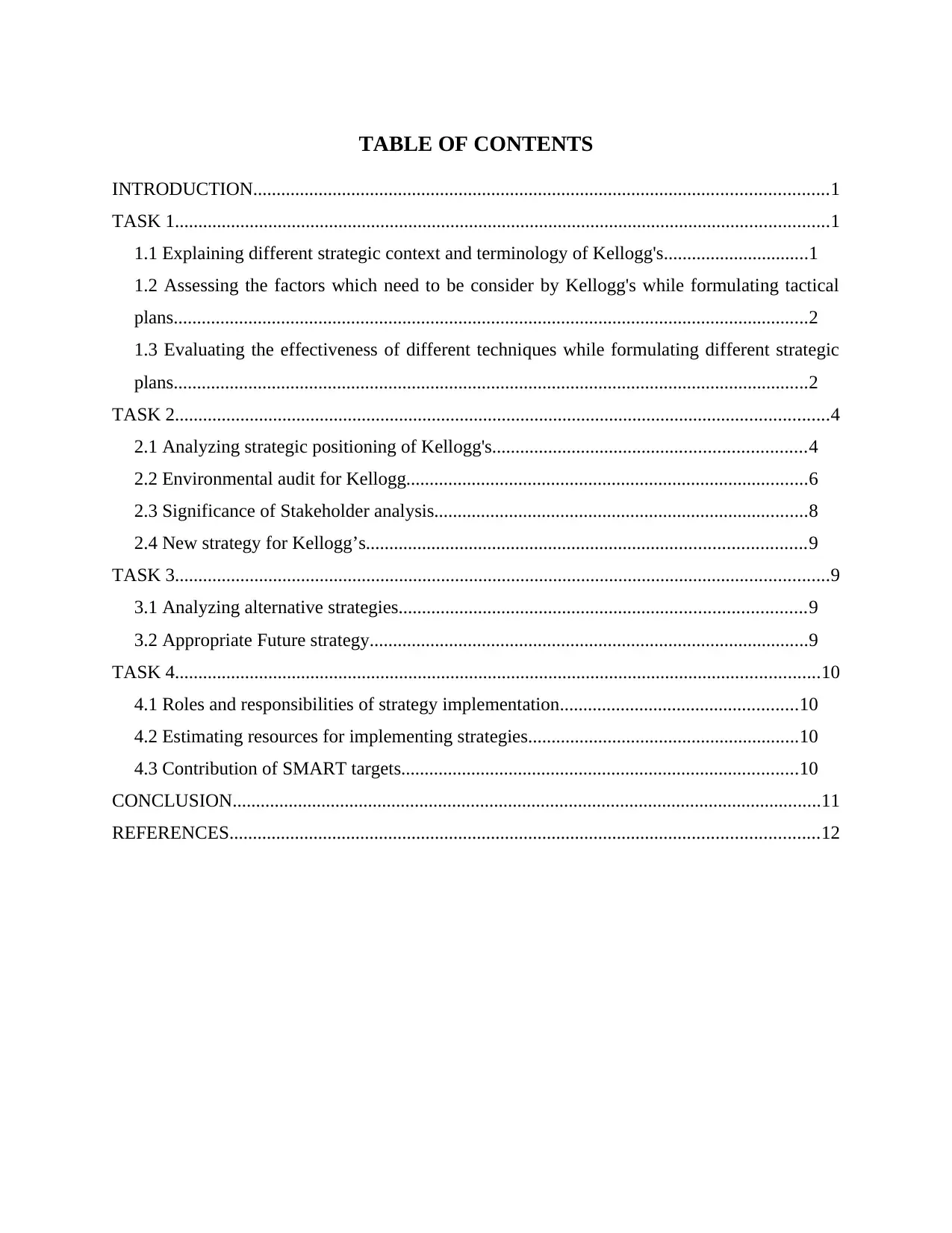
TABLE OF CONTENTS
INTRODUCTION...........................................................................................................................1
TASK 1............................................................................................................................................1
1.1 Explaining different strategic context and terminology of Kellogg's...............................1
1.2 Assessing the factors which need to be consider by Kellogg's while formulating tactical
plans........................................................................................................................................2
1.3 Evaluating the effectiveness of different techniques while formulating different strategic
plans........................................................................................................................................2
TASK 2............................................................................................................................................4
2.1 Analyzing strategic positioning of Kellogg's...................................................................4
2.2 Environmental audit for Kellogg......................................................................................6
2.3 Significance of Stakeholder analysis................................................................................8
2.4 New strategy for Kellogg’s..............................................................................................9
TASK 3............................................................................................................................................9
3.1 Analyzing alternative strategies.......................................................................................9
3.2 Appropriate Future strategy..............................................................................................9
TASK 4..........................................................................................................................................10
4.1 Roles and responsibilities of strategy implementation...................................................10
4.2 Estimating resources for implementing strategies..........................................................10
4.3 Contribution of SMART targets.....................................................................................10
CONCLUSION..............................................................................................................................11
REFERENCES..............................................................................................................................12
INTRODUCTION...........................................................................................................................1
TASK 1............................................................................................................................................1
1.1 Explaining different strategic context and terminology of Kellogg's...............................1
1.2 Assessing the factors which need to be consider by Kellogg's while formulating tactical
plans........................................................................................................................................2
1.3 Evaluating the effectiveness of different techniques while formulating different strategic
plans........................................................................................................................................2
TASK 2............................................................................................................................................4
2.1 Analyzing strategic positioning of Kellogg's...................................................................4
2.2 Environmental audit for Kellogg......................................................................................6
2.3 Significance of Stakeholder analysis................................................................................8
2.4 New strategy for Kellogg’s..............................................................................................9
TASK 3............................................................................................................................................9
3.1 Analyzing alternative strategies.......................................................................................9
3.2 Appropriate Future strategy..............................................................................................9
TASK 4..........................................................................................................................................10
4.1 Roles and responsibilities of strategy implementation...................................................10
4.2 Estimating resources for implementing strategies..........................................................10
4.3 Contribution of SMART targets.....................................................................................10
CONCLUSION..............................................................................................................................11
REFERENCES..............................................................................................................................12
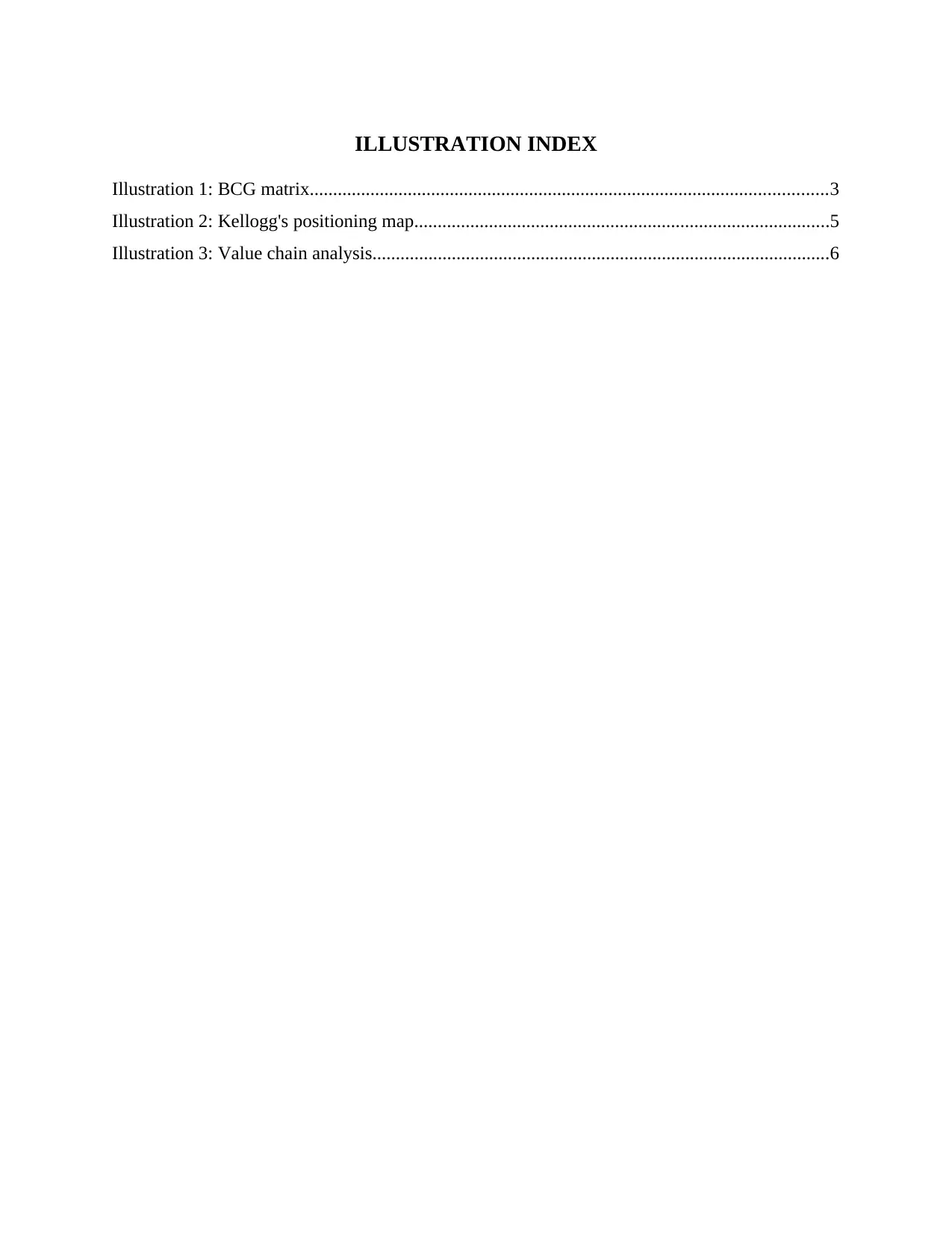
ILLUSTRATION INDEX
Illustration 1: BCG matrix...............................................................................................................3
Illustration 2: Kellogg's positioning map.........................................................................................5
Illustration 3: Value chain analysis..................................................................................................6
Illustration 1: BCG matrix...............................................................................................................3
Illustration 2: Kellogg's positioning map.........................................................................................5
Illustration 3: Value chain analysis..................................................................................................6
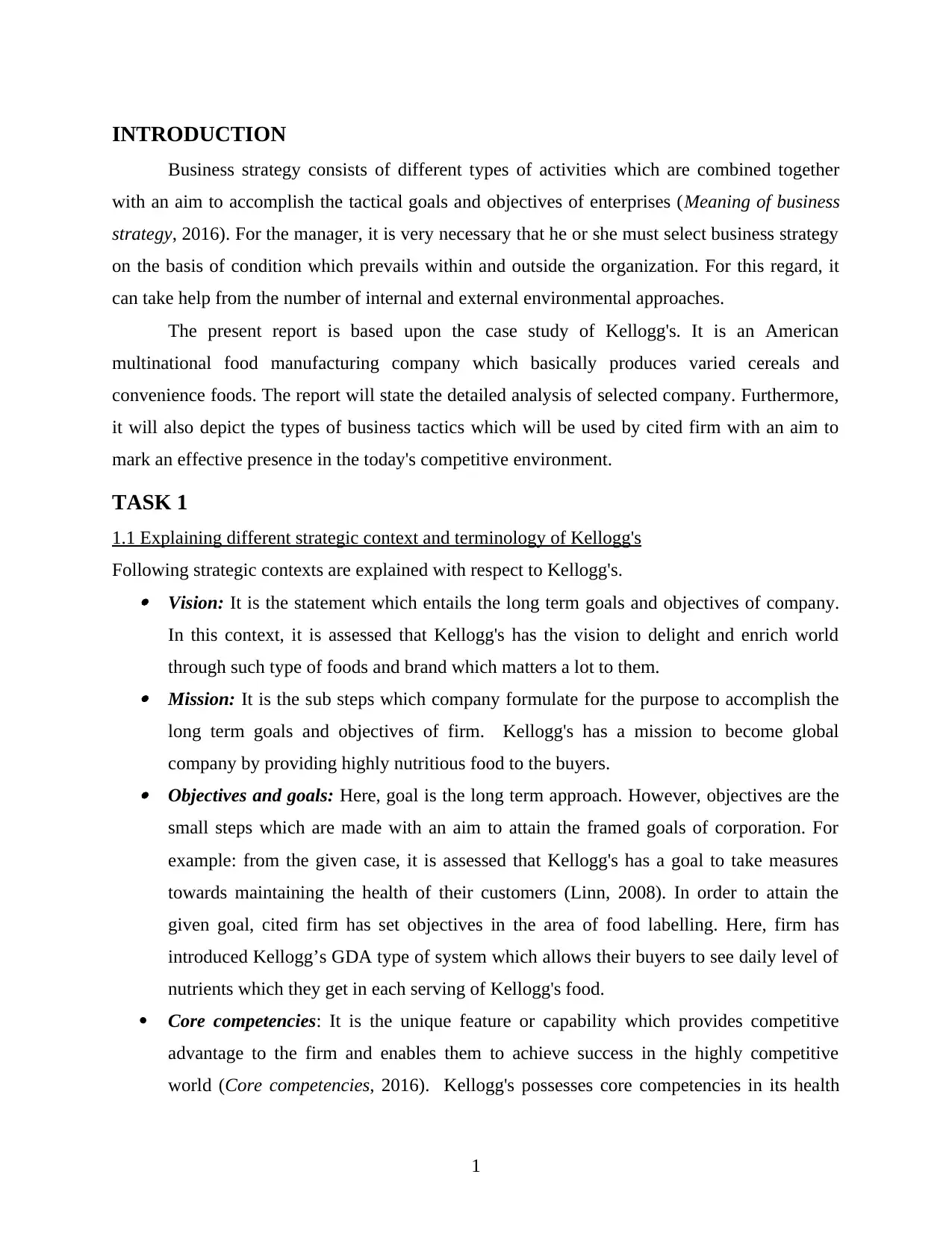
INTRODUCTION
Business strategy consists of different types of activities which are combined together
with an aim to accomplish the tactical goals and objectives of enterprises (Meaning of business
strategy, 2016). For the manager, it is very necessary that he or she must select business strategy
on the basis of condition which prevails within and outside the organization. For this regard, it
can take help from the number of internal and external environmental approaches.
The present report is based upon the case study of Kellogg's. It is an American
multinational food manufacturing company which basically produces varied cereals and
convenience foods. The report will state the detailed analysis of selected company. Furthermore,
it will also depict the types of business tactics which will be used by cited firm with an aim to
mark an effective presence in the today's competitive environment.
TASK 1
1.1 Explaining different strategic context and terminology of Kellogg's
Following strategic contexts are explained with respect to Kellogg's. Vision: It is the statement which entails the long term goals and objectives of company.
In this context, it is assessed that Kellogg's has the vision to delight and enrich world
through such type of foods and brand which matters a lot to them. Mission: It is the sub steps which company formulate for the purpose to accomplish the
long term goals and objectives of firm. Kellogg's has a mission to become global
company by providing highly nutritious food to the buyers. Objectives and goals: Here, goal is the long term approach. However, objectives are the
small steps which are made with an aim to attain the framed goals of corporation. For
example: from the given case, it is assessed that Kellogg's has a goal to take measures
towards maintaining the health of their customers (Linn, 2008). In order to attain the
given goal, cited firm has set objectives in the area of food labelling. Here, firm has
introduced Kellogg’s GDA type of system which allows their buyers to see daily level of
nutrients which they get in each serving of Kellogg's food.
Core competencies: It is the unique feature or capability which provides competitive
advantage to the firm and enables them to achieve success in the highly competitive
world (Core competencies, 2016). Kellogg's possesses core competencies in its health
1
Business strategy consists of different types of activities which are combined together
with an aim to accomplish the tactical goals and objectives of enterprises (Meaning of business
strategy, 2016). For the manager, it is very necessary that he or she must select business strategy
on the basis of condition which prevails within and outside the organization. For this regard, it
can take help from the number of internal and external environmental approaches.
The present report is based upon the case study of Kellogg's. It is an American
multinational food manufacturing company which basically produces varied cereals and
convenience foods. The report will state the detailed analysis of selected company. Furthermore,
it will also depict the types of business tactics which will be used by cited firm with an aim to
mark an effective presence in the today's competitive environment.
TASK 1
1.1 Explaining different strategic context and terminology of Kellogg's
Following strategic contexts are explained with respect to Kellogg's. Vision: It is the statement which entails the long term goals and objectives of company.
In this context, it is assessed that Kellogg's has the vision to delight and enrich world
through such type of foods and brand which matters a lot to them. Mission: It is the sub steps which company formulate for the purpose to accomplish the
long term goals and objectives of firm. Kellogg's has a mission to become global
company by providing highly nutritious food to the buyers. Objectives and goals: Here, goal is the long term approach. However, objectives are the
small steps which are made with an aim to attain the framed goals of corporation. For
example: from the given case, it is assessed that Kellogg's has a goal to take measures
towards maintaining the health of their customers (Linn, 2008). In order to attain the
given goal, cited firm has set objectives in the area of food labelling. Here, firm has
introduced Kellogg’s GDA type of system which allows their buyers to see daily level of
nutrients which they get in each serving of Kellogg's food.
Core competencies: It is the unique feature or capability which provides competitive
advantage to the firm and enables them to achieve success in the highly competitive
world (Core competencies, 2016). Kellogg's possesses core competencies in its health
1
Secure Best Marks with AI Grader
Need help grading? Try our AI Grader for instant feedback on your assignments.
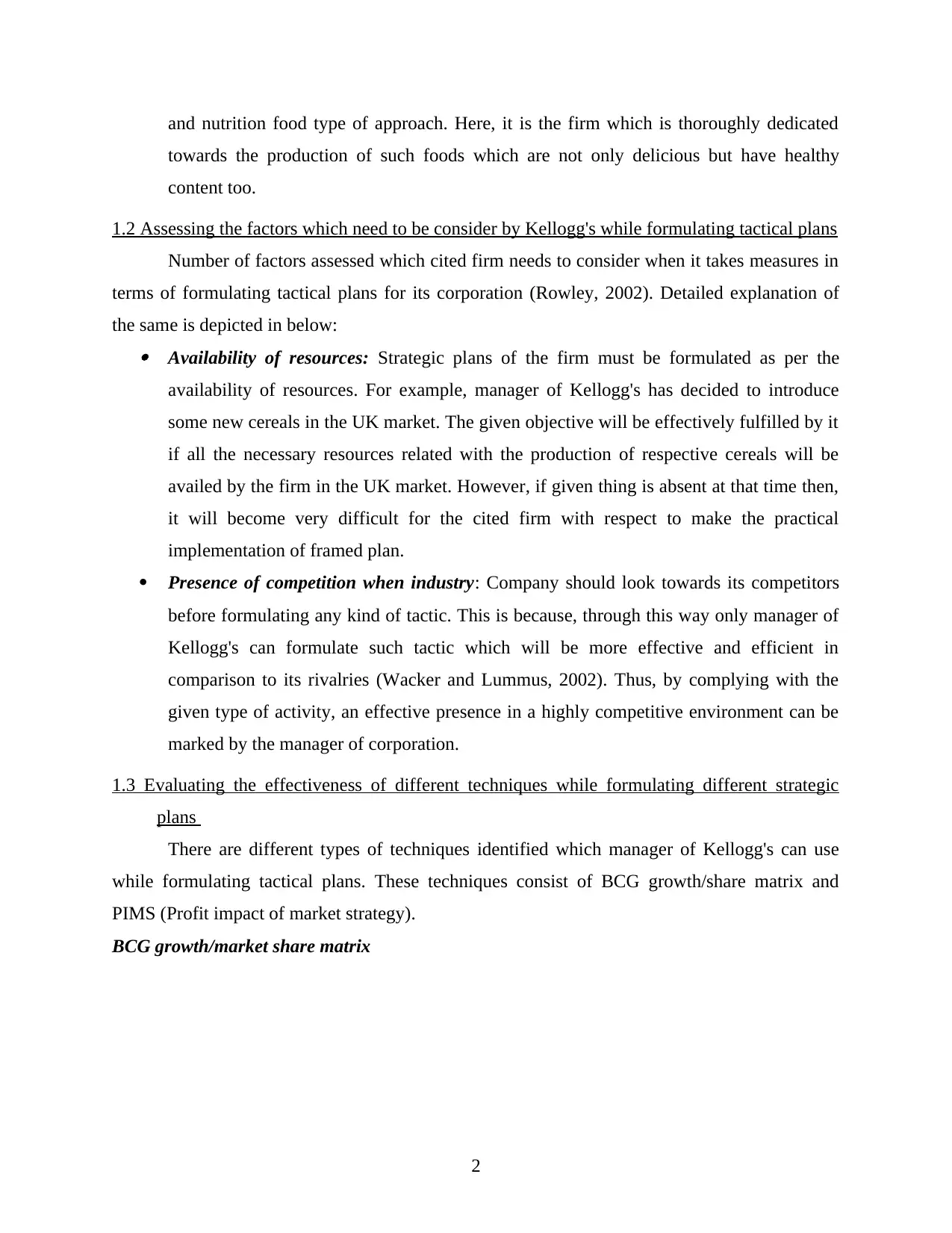
and nutrition food type of approach. Here, it is the firm which is thoroughly dedicated
towards the production of such foods which are not only delicious but have healthy
content too.
1.2 Assessing the factors which need to be consider by Kellogg's while formulating tactical plans
Number of factors assessed which cited firm needs to consider when it takes measures in
terms of formulating tactical plans for its corporation (Rowley, 2002). Detailed explanation of
the same is depicted in below: Availability of resources: Strategic plans of the firm must be formulated as per the
availability of resources. For example, manager of Kellogg's has decided to introduce
some new cereals in the UK market. The given objective will be effectively fulfilled by it
if all the necessary resources related with the production of respective cereals will be
availed by the firm in the UK market. However, if given thing is absent at that time then,
it will become very difficult for the cited firm with respect to make the practical
implementation of framed plan.
Presence of competition when industry: Company should look towards its competitors
before formulating any kind of tactic. This is because, through this way only manager of
Kellogg's can formulate such tactic which will be more effective and efficient in
comparison to its rivalries (Wacker and Lummus, 2002). Thus, by complying with the
given type of activity, an effective presence in a highly competitive environment can be
marked by the manager of corporation.
1.3 Evaluating the effectiveness of different techniques while formulating different strategic
plans
There are different types of techniques identified which manager of Kellogg's can use
while formulating tactical plans. These techniques consist of BCG growth/share matrix and
PIMS (Profit impact of market strategy).
BCG growth/market share matrix
2
towards the production of such foods which are not only delicious but have healthy
content too.
1.2 Assessing the factors which need to be consider by Kellogg's while formulating tactical plans
Number of factors assessed which cited firm needs to consider when it takes measures in
terms of formulating tactical plans for its corporation (Rowley, 2002). Detailed explanation of
the same is depicted in below: Availability of resources: Strategic plans of the firm must be formulated as per the
availability of resources. For example, manager of Kellogg's has decided to introduce
some new cereals in the UK market. The given objective will be effectively fulfilled by it
if all the necessary resources related with the production of respective cereals will be
availed by the firm in the UK market. However, if given thing is absent at that time then,
it will become very difficult for the cited firm with respect to make the practical
implementation of framed plan.
Presence of competition when industry: Company should look towards its competitors
before formulating any kind of tactic. This is because, through this way only manager of
Kellogg's can formulate such tactic which will be more effective and efficient in
comparison to its rivalries (Wacker and Lummus, 2002). Thus, by complying with the
given type of activity, an effective presence in a highly competitive environment can be
marked by the manager of corporation.
1.3 Evaluating the effectiveness of different techniques while formulating different strategic
plans
There are different types of techniques identified which manager of Kellogg's can use
while formulating tactical plans. These techniques consist of BCG growth/share matrix and
PIMS (Profit impact of market strategy).
BCG growth/market share matrix
2
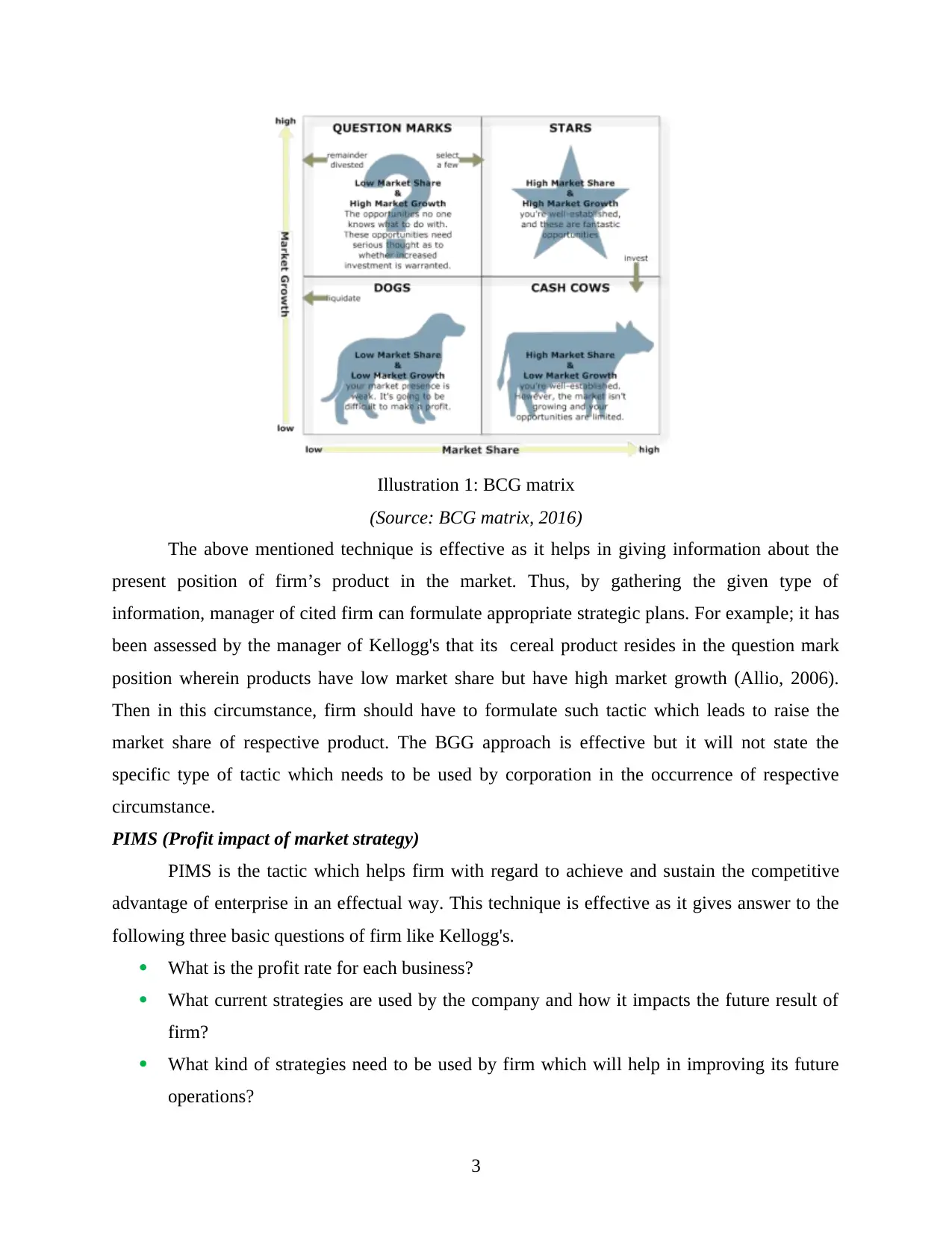
Illustration 1: BCG matrix
(Source: BCG matrix, 2016)
The above mentioned technique is effective as it helps in giving information about the
present position of firm’s product in the market. Thus, by gathering the given type of
information, manager of cited firm can formulate appropriate strategic plans. For example; it has
been assessed by the manager of Kellogg's that its cereal product resides in the question mark
position wherein products have low market share but have high market growth (Allio, 2006).
Then in this circumstance, firm should have to formulate such tactic which leads to raise the
market share of respective product. The BGG approach is effective but it will not state the
specific type of tactic which needs to be used by corporation in the occurrence of respective
circumstance.
PIMS (Profit impact of market strategy)
PIMS is the tactic which helps firm with regard to achieve and sustain the competitive
advantage of enterprise in an effectual way. This technique is effective as it gives answer to the
following three basic questions of firm like Kellogg's.
What is the profit rate for each business?
What current strategies are used by the company and how it impacts the future result of
firm?
What kind of strategies need to be used by firm which will help in improving its future
operations?
3
(Source: BCG matrix, 2016)
The above mentioned technique is effective as it helps in giving information about the
present position of firm’s product in the market. Thus, by gathering the given type of
information, manager of cited firm can formulate appropriate strategic plans. For example; it has
been assessed by the manager of Kellogg's that its cereal product resides in the question mark
position wherein products have low market share but have high market growth (Allio, 2006).
Then in this circumstance, firm should have to formulate such tactic which leads to raise the
market share of respective product. The BGG approach is effective but it will not state the
specific type of tactic which needs to be used by corporation in the occurrence of respective
circumstance.
PIMS (Profit impact of market strategy)
PIMS is the tactic which helps firm with regard to achieve and sustain the competitive
advantage of enterprise in an effectual way. This technique is effective as it gives answer to the
following three basic questions of firm like Kellogg's.
What is the profit rate for each business?
What current strategies are used by the company and how it impacts the future result of
firm?
What kind of strategies need to be used by firm which will help in improving its future
operations?
3
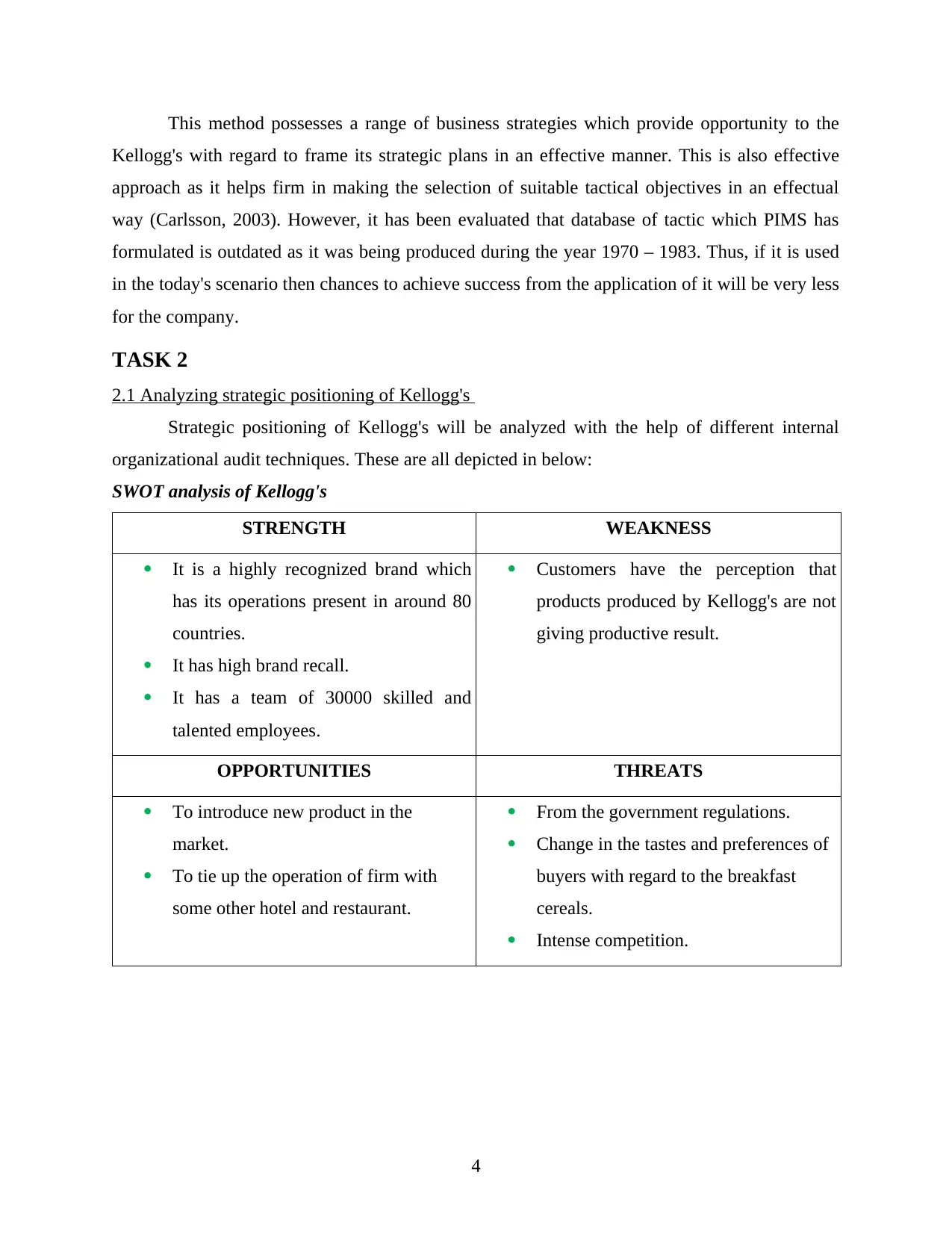
This method possesses a range of business strategies which provide opportunity to the
Kellogg's with regard to frame its strategic plans in an effective manner. This is also effective
approach as it helps firm in making the selection of suitable tactical objectives in an effectual
way (Carlsson, 2003). However, it has been evaluated that database of tactic which PIMS has
formulated is outdated as it was being produced during the year 1970 – 1983. Thus, if it is used
in the today's scenario then chances to achieve success from the application of it will be very less
for the company.
TASK 2
2.1 Analyzing strategic positioning of Kellogg's
Strategic positioning of Kellogg's will be analyzed with the help of different internal
organizational audit techniques. These are all depicted in below:
SWOT analysis of Kellogg's
STRENGTH WEAKNESS
It is a highly recognized brand which
has its operations present in around 80
countries.
It has high brand recall.
It has a team of 30000 skilled and
talented employees.
Customers have the perception that
products produced by Kellogg's are not
giving productive result.
OPPORTUNITIES THREATS
To introduce new product in the
market.
To tie up the operation of firm with
some other hotel and restaurant.
From the government regulations.
Change in the tastes and preferences of
buyers with regard to the breakfast
cereals.
Intense competition.
4
Kellogg's with regard to frame its strategic plans in an effective manner. This is also effective
approach as it helps firm in making the selection of suitable tactical objectives in an effectual
way (Carlsson, 2003). However, it has been evaluated that database of tactic which PIMS has
formulated is outdated as it was being produced during the year 1970 – 1983. Thus, if it is used
in the today's scenario then chances to achieve success from the application of it will be very less
for the company.
TASK 2
2.1 Analyzing strategic positioning of Kellogg's
Strategic positioning of Kellogg's will be analyzed with the help of different internal
organizational audit techniques. These are all depicted in below:
SWOT analysis of Kellogg's
STRENGTH WEAKNESS
It is a highly recognized brand which
has its operations present in around 80
countries.
It has high brand recall.
It has a team of 30000 skilled and
talented employees.
Customers have the perception that
products produced by Kellogg's are not
giving productive result.
OPPORTUNITIES THREATS
To introduce new product in the
market.
To tie up the operation of firm with
some other hotel and restaurant.
From the government regulations.
Change in the tastes and preferences of
buyers with regard to the breakfast
cereals.
Intense competition.
4
Paraphrase This Document
Need a fresh take? Get an instant paraphrase of this document with our AI Paraphraser
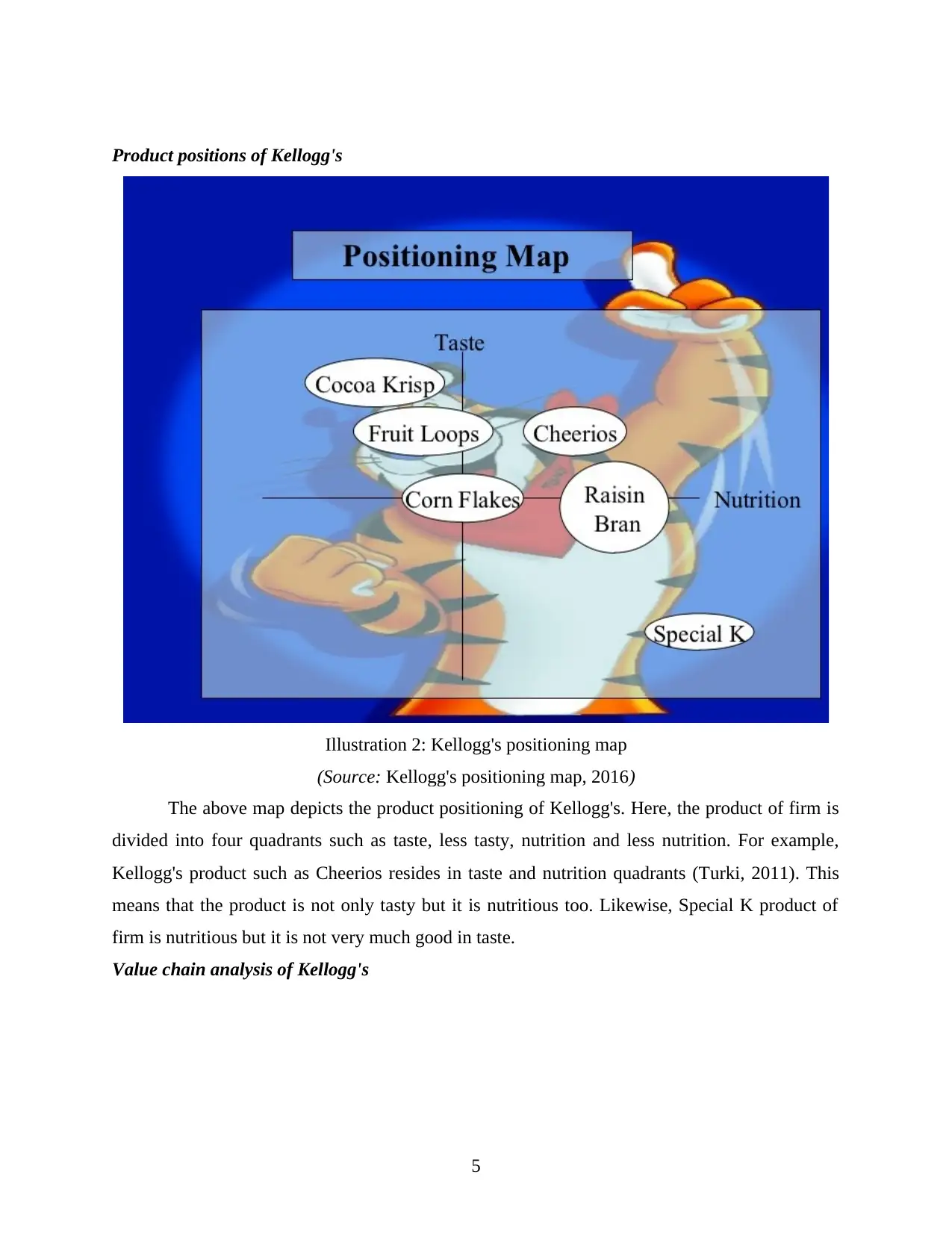
Product positions of Kellogg's
The above map depicts the product positioning of Kellogg's. Here, the product of firm is
divided into four quadrants such as taste, less tasty, nutrition and less nutrition. For example,
Kellogg's product such as Cheerios resides in taste and nutrition quadrants (Turki, 2011). This
means that the product is not only tasty but it is nutritious too. Likewise, Special K product of
firm is nutritious but it is not very much good in taste.
Value chain analysis of Kellogg's
5
Illustration 2: Kellogg's positioning map
(Source: Kellogg's positioning map, 2016)
The above map depicts the product positioning of Kellogg's. Here, the product of firm is
divided into four quadrants such as taste, less tasty, nutrition and less nutrition. For example,
Kellogg's product such as Cheerios resides in taste and nutrition quadrants (Turki, 2011). This
means that the product is not only tasty but it is nutritious too. Likewise, Special K product of
firm is nutritious but it is not very much good in taste.
Value chain analysis of Kellogg's
5
Illustration 2: Kellogg's positioning map
(Source: Kellogg's positioning map, 2016)
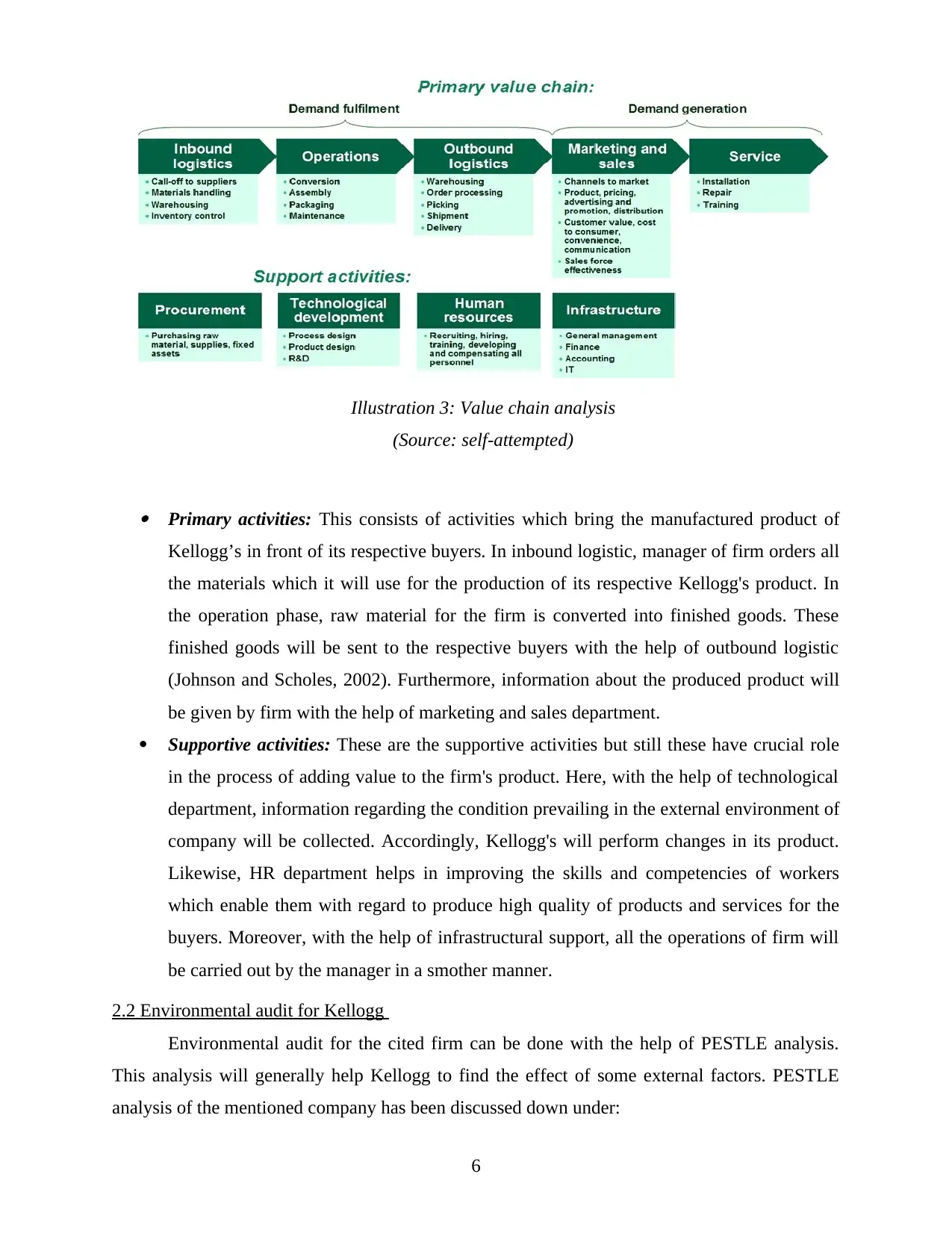
Primary activities: This consists of activities which bring the manufactured product of
Kellogg’s in front of its respective buyers. In inbound logistic, manager of firm orders all
the materials which it will use for the production of its respective Kellogg's product. In
the operation phase, raw material for the firm is converted into finished goods. These
finished goods will be sent to the respective buyers with the help of outbound logistic
(Johnson and Scholes, 2002). Furthermore, information about the produced product will
be given by firm with the help of marketing and sales department.
Supportive activities: These are the supportive activities but still these have crucial role
in the process of adding value to the firm's product. Here, with the help of technological
department, information regarding the condition prevailing in the external environment of
company will be collected. Accordingly, Kellogg's will perform changes in its product.
Likewise, HR department helps in improving the skills and competencies of workers
which enable them with regard to produce high quality of products and services for the
buyers. Moreover, with the help of infrastructural support, all the operations of firm will
be carried out by the manager in a smother manner.
2.2 Environmental audit for Kellogg
Environmental audit for the cited firm can be done with the help of PESTLE analysis.
This analysis will generally help Kellogg to find the effect of some external factors. PESTLE
analysis of the mentioned company has been discussed down under:
6
Illustration 3: Value chain analysis
(Source: self-attempted)
Kellogg’s in front of its respective buyers. In inbound logistic, manager of firm orders all
the materials which it will use for the production of its respective Kellogg's product. In
the operation phase, raw material for the firm is converted into finished goods. These
finished goods will be sent to the respective buyers with the help of outbound logistic
(Johnson and Scholes, 2002). Furthermore, information about the produced product will
be given by firm with the help of marketing and sales department.
Supportive activities: These are the supportive activities but still these have crucial role
in the process of adding value to the firm's product. Here, with the help of technological
department, information regarding the condition prevailing in the external environment of
company will be collected. Accordingly, Kellogg's will perform changes in its product.
Likewise, HR department helps in improving the skills and competencies of workers
which enable them with regard to produce high quality of products and services for the
buyers. Moreover, with the help of infrastructural support, all the operations of firm will
be carried out by the manager in a smother manner.
2.2 Environmental audit for Kellogg
Environmental audit for the cited firm can be done with the help of PESTLE analysis.
This analysis will generally help Kellogg to find the effect of some external factors. PESTLE
analysis of the mentioned company has been discussed down under:
6
Illustration 3: Value chain analysis
(Source: self-attempted)
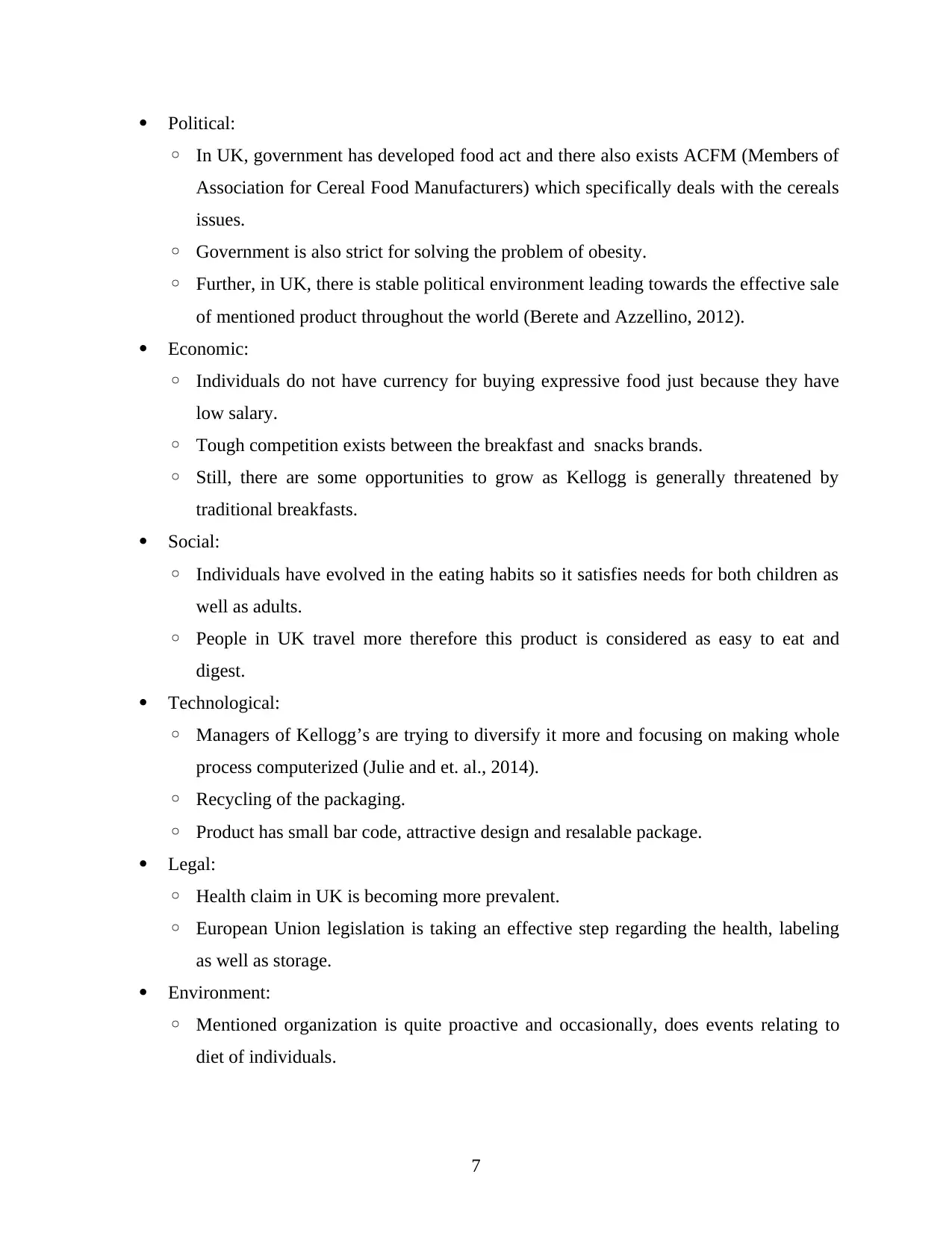
Political:
◦ In UK, government has developed food act and there also exists ACFM (Members of
Association for Cereal Food Manufacturers) which specifically deals with the cereals
issues.
◦ Government is also strict for solving the problem of obesity.
◦ Further, in UK, there is stable political environment leading towards the effective sale
of mentioned product throughout the world (Berete and Azzellino, 2012).
Economic:
◦ Individuals do not have currency for buying expressive food just because they have
low salary.
◦ Tough competition exists between the breakfast and snacks brands.
◦ Still, there are some opportunities to grow as Kellogg is generally threatened by
traditional breakfasts.
Social:
◦ Individuals have evolved in the eating habits so it satisfies needs for both children as
well as adults.
◦ People in UK travel more therefore this product is considered as easy to eat and
digest.
Technological:
◦ Managers of Kellogg’s are trying to diversify it more and focusing on making whole
process computerized (Julie and et. al., 2014).
◦ Recycling of the packaging.
◦ Product has small bar code, attractive design and resalable package.
Legal:
◦ Health claim in UK is becoming more prevalent.
◦ European Union legislation is taking an effective step regarding the health, labeling
as well as storage.
Environment:
◦ Mentioned organization is quite proactive and occasionally, does events relating to
diet of individuals.
7
◦ In UK, government has developed food act and there also exists ACFM (Members of
Association for Cereal Food Manufacturers) which specifically deals with the cereals
issues.
◦ Government is also strict for solving the problem of obesity.
◦ Further, in UK, there is stable political environment leading towards the effective sale
of mentioned product throughout the world (Berete and Azzellino, 2012).
Economic:
◦ Individuals do not have currency for buying expressive food just because they have
low salary.
◦ Tough competition exists between the breakfast and snacks brands.
◦ Still, there are some opportunities to grow as Kellogg is generally threatened by
traditional breakfasts.
Social:
◦ Individuals have evolved in the eating habits so it satisfies needs for both children as
well as adults.
◦ People in UK travel more therefore this product is considered as easy to eat and
digest.
Technological:
◦ Managers of Kellogg’s are trying to diversify it more and focusing on making whole
process computerized (Julie and et. al., 2014).
◦ Recycling of the packaging.
◦ Product has small bar code, attractive design and resalable package.
Legal:
◦ Health claim in UK is becoming more prevalent.
◦ European Union legislation is taking an effective step regarding the health, labeling
as well as storage.
Environment:
◦ Mentioned organization is quite proactive and occasionally, does events relating to
diet of individuals.
7
Secure Best Marks with AI Grader
Need help grading? Try our AI Grader for instant feedback on your assignments.
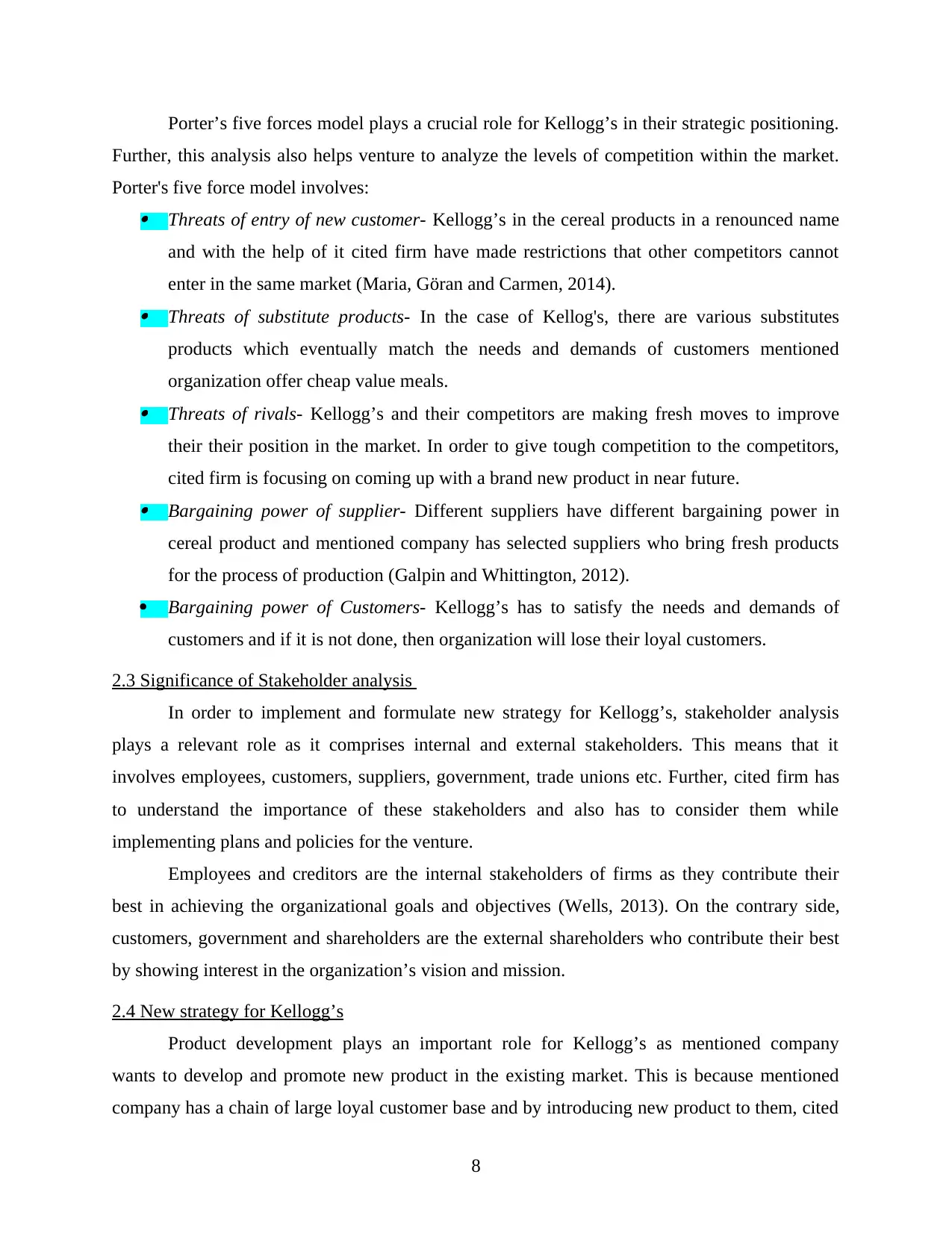
Porter’s five forces model plays a crucial role for Kellogg’s in their strategic positioning.
Further, this analysis also helps venture to analyze the levels of competition within the market.
Porter's five force model involves: Threats of entry of new customer- Kellogg’s in the cereal products in a renounced name
and with the help of it cited firm have made restrictions that other competitors cannot
enter in the same market (Maria, Göran and Carmen, 2014). Threats of substitute products- In the case of Kellog's, there are various substitutes
products which eventually match the needs and demands of customers mentioned
organization offer cheap value meals. Threats of rivals- Kellogg’s and their competitors are making fresh moves to improve
their their position in the market. In order to give tough competition to the competitors,
cited firm is focusing on coming up with a brand new product in near future. Bargaining power of supplier- Different suppliers have different bargaining power in
cereal product and mentioned company has selected suppliers who bring fresh products
for the process of production (Galpin and Whittington, 2012).
Bargaining power of Customers- Kellogg’s has to satisfy the needs and demands of
customers and if it is not done, then organization will lose their loyal customers.
2.3 Significance of Stakeholder analysis
In order to implement and formulate new strategy for Kellogg’s, stakeholder analysis
plays a relevant role as it comprises internal and external stakeholders. This means that it
involves employees, customers, suppliers, government, trade unions etc. Further, cited firm has
to understand the importance of these stakeholders and also has to consider them while
implementing plans and policies for the venture.
Employees and creditors are the internal stakeholders of firms as they contribute their
best in achieving the organizational goals and objectives (Wells, 2013). On the contrary side,
customers, government and shareholders are the external shareholders who contribute their best
by showing interest in the organization’s vision and mission.
2.4 New strategy for Kellogg’s
Product development plays an important role for Kellogg’s as mentioned company
wants to develop and promote new product in the existing market. This is because mentioned
company has a chain of large loyal customer base and by introducing new product to them, cited
8
Further, this analysis also helps venture to analyze the levels of competition within the market.
Porter's five force model involves: Threats of entry of new customer- Kellogg’s in the cereal products in a renounced name
and with the help of it cited firm have made restrictions that other competitors cannot
enter in the same market (Maria, Göran and Carmen, 2014). Threats of substitute products- In the case of Kellog's, there are various substitutes
products which eventually match the needs and demands of customers mentioned
organization offer cheap value meals. Threats of rivals- Kellogg’s and their competitors are making fresh moves to improve
their their position in the market. In order to give tough competition to the competitors,
cited firm is focusing on coming up with a brand new product in near future. Bargaining power of supplier- Different suppliers have different bargaining power in
cereal product and mentioned company has selected suppliers who bring fresh products
for the process of production (Galpin and Whittington, 2012).
Bargaining power of Customers- Kellogg’s has to satisfy the needs and demands of
customers and if it is not done, then organization will lose their loyal customers.
2.3 Significance of Stakeholder analysis
In order to implement and formulate new strategy for Kellogg’s, stakeholder analysis
plays a relevant role as it comprises internal and external stakeholders. This means that it
involves employees, customers, suppliers, government, trade unions etc. Further, cited firm has
to understand the importance of these stakeholders and also has to consider them while
implementing plans and policies for the venture.
Employees and creditors are the internal stakeholders of firms as they contribute their
best in achieving the organizational goals and objectives (Wells, 2013). On the contrary side,
customers, government and shareholders are the external shareholders who contribute their best
by showing interest in the organization’s vision and mission.
2.4 New strategy for Kellogg’s
Product development plays an important role for Kellogg’s as mentioned company
wants to develop and promote new product in the existing market. This is because mentioned
company has a chain of large loyal customer base and by introducing new product to them, cited
8
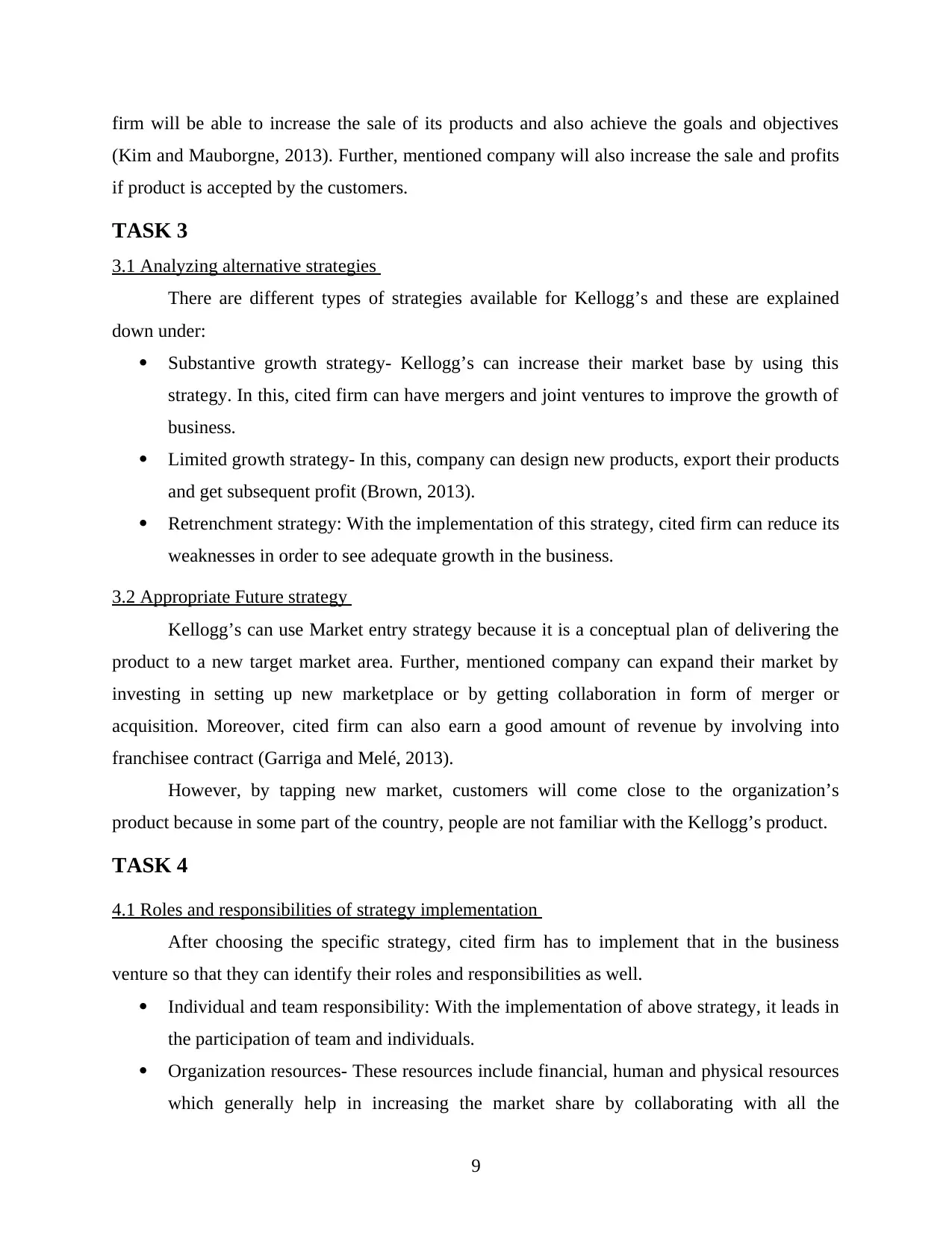
firm will be able to increase the sale of its products and also achieve the goals and objectives
(Kim and Mauborgne, 2013). Further, mentioned company will also increase the sale and profits
if product is accepted by the customers.
TASK 3
3.1 Analyzing alternative strategies
There are different types of strategies available for Kellogg’s and these are explained
down under:
Substantive growth strategy- Kellogg’s can increase their market base by using this
strategy. In this, cited firm can have mergers and joint ventures to improve the growth of
business.
Limited growth strategy- In this, company can design new products, export their products
and get subsequent profit (Brown, 2013).
Retrenchment strategy: With the implementation of this strategy, cited firm can reduce its
weaknesses in order to see adequate growth in the business.
3.2 Appropriate Future strategy
Kellogg’s can use Market entry strategy because it is a conceptual plan of delivering the
product to a new target market area. Further, mentioned company can expand their market by
investing in setting up new marketplace or by getting collaboration in form of merger or
acquisition. Moreover, cited firm can also earn a good amount of revenue by involving into
franchisee contract (Garriga and Melé, 2013).
However, by tapping new market, customers will come close to the organization’s
product because in some part of the country, people are not familiar with the Kellogg’s product.
TASK 4
4.1 Roles and responsibilities of strategy implementation
After choosing the specific strategy, cited firm has to implement that in the business
venture so that they can identify their roles and responsibilities as well.
Individual and team responsibility: With the implementation of above strategy, it leads in
the participation of team and individuals.
Organization resources- These resources include financial, human and physical resources
which generally help in increasing the market share by collaborating with all the
9
(Kim and Mauborgne, 2013). Further, mentioned company will also increase the sale and profits
if product is accepted by the customers.
TASK 3
3.1 Analyzing alternative strategies
There are different types of strategies available for Kellogg’s and these are explained
down under:
Substantive growth strategy- Kellogg’s can increase their market base by using this
strategy. In this, cited firm can have mergers and joint ventures to improve the growth of
business.
Limited growth strategy- In this, company can design new products, export their products
and get subsequent profit (Brown, 2013).
Retrenchment strategy: With the implementation of this strategy, cited firm can reduce its
weaknesses in order to see adequate growth in the business.
3.2 Appropriate Future strategy
Kellogg’s can use Market entry strategy because it is a conceptual plan of delivering the
product to a new target market area. Further, mentioned company can expand their market by
investing in setting up new marketplace or by getting collaboration in form of merger or
acquisition. Moreover, cited firm can also earn a good amount of revenue by involving into
franchisee contract (Garriga and Melé, 2013).
However, by tapping new market, customers will come close to the organization’s
product because in some part of the country, people are not familiar with the Kellogg’s product.
TASK 4
4.1 Roles and responsibilities of strategy implementation
After choosing the specific strategy, cited firm has to implement that in the business
venture so that they can identify their roles and responsibilities as well.
Individual and team responsibility: With the implementation of above strategy, it leads in
the participation of team and individuals.
Organization resources- These resources include financial, human and physical resources
which generally help in increasing the market share by collaborating with all the
9
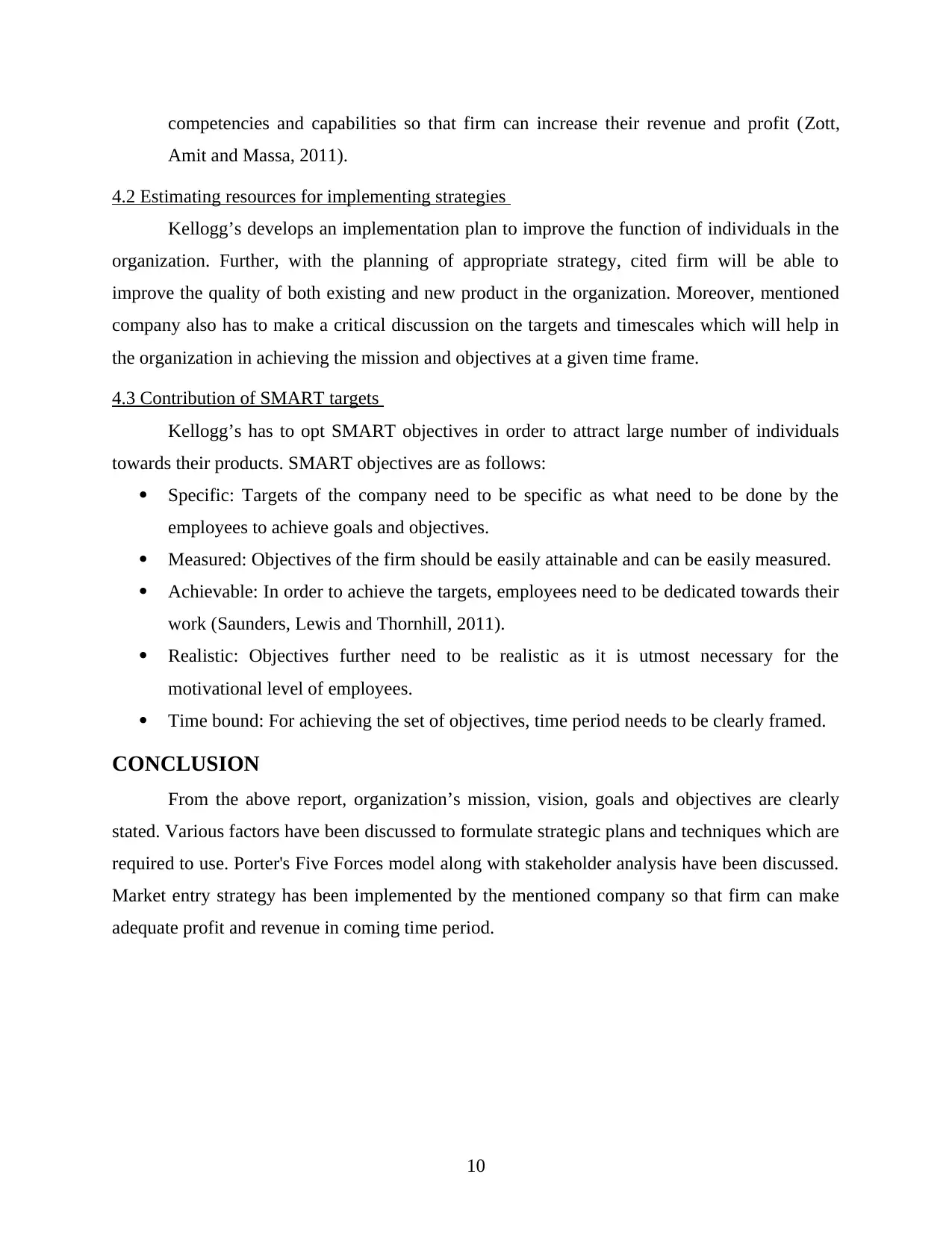
competencies and capabilities so that firm can increase their revenue and profit (Zott,
Amit and Massa, 2011).
4.2 Estimating resources for implementing strategies
Kellogg’s develops an implementation plan to improve the function of individuals in the
organization. Further, with the planning of appropriate strategy, cited firm will be able to
improve the quality of both existing and new product in the organization. Moreover, mentioned
company also has to make a critical discussion on the targets and timescales which will help in
the organization in achieving the mission and objectives at a given time frame.
4.3 Contribution of SMART targets
Kellogg’s has to opt SMART objectives in order to attract large number of individuals
towards their products. SMART objectives are as follows:
Specific: Targets of the company need to be specific as what need to be done by the
employees to achieve goals and objectives.
Measured: Objectives of the firm should be easily attainable and can be easily measured.
Achievable: In order to achieve the targets, employees need to be dedicated towards their
work (Saunders, Lewis and Thornhill, 2011).
Realistic: Objectives further need to be realistic as it is utmost necessary for the
motivational level of employees.
Time bound: For achieving the set of objectives, time period needs to be clearly framed.
CONCLUSION
From the above report, organization’s mission, vision, goals and objectives are clearly
stated. Various factors have been discussed to formulate strategic plans and techniques which are
required to use. Porter's Five Forces model along with stakeholder analysis have been discussed.
Market entry strategy has been implemented by the mentioned company so that firm can make
adequate profit and revenue in coming time period.
10
Amit and Massa, 2011).
4.2 Estimating resources for implementing strategies
Kellogg’s develops an implementation plan to improve the function of individuals in the
organization. Further, with the planning of appropriate strategy, cited firm will be able to
improve the quality of both existing and new product in the organization. Moreover, mentioned
company also has to make a critical discussion on the targets and timescales which will help in
the organization in achieving the mission and objectives at a given time frame.
4.3 Contribution of SMART targets
Kellogg’s has to opt SMART objectives in order to attract large number of individuals
towards their products. SMART objectives are as follows:
Specific: Targets of the company need to be specific as what need to be done by the
employees to achieve goals and objectives.
Measured: Objectives of the firm should be easily attainable and can be easily measured.
Achievable: In order to achieve the targets, employees need to be dedicated towards their
work (Saunders, Lewis and Thornhill, 2011).
Realistic: Objectives further need to be realistic as it is utmost necessary for the
motivational level of employees.
Time bound: For achieving the set of objectives, time period needs to be clearly framed.
CONCLUSION
From the above report, organization’s mission, vision, goals and objectives are clearly
stated. Various factors have been discussed to formulate strategic plans and techniques which are
required to use. Porter's Five Forces model along with stakeholder analysis have been discussed.
Market entry strategy has been implemented by the mentioned company so that firm can make
adequate profit and revenue in coming time period.
10
Paraphrase This Document
Need a fresh take? Get an instant paraphrase of this document with our AI Paraphraser
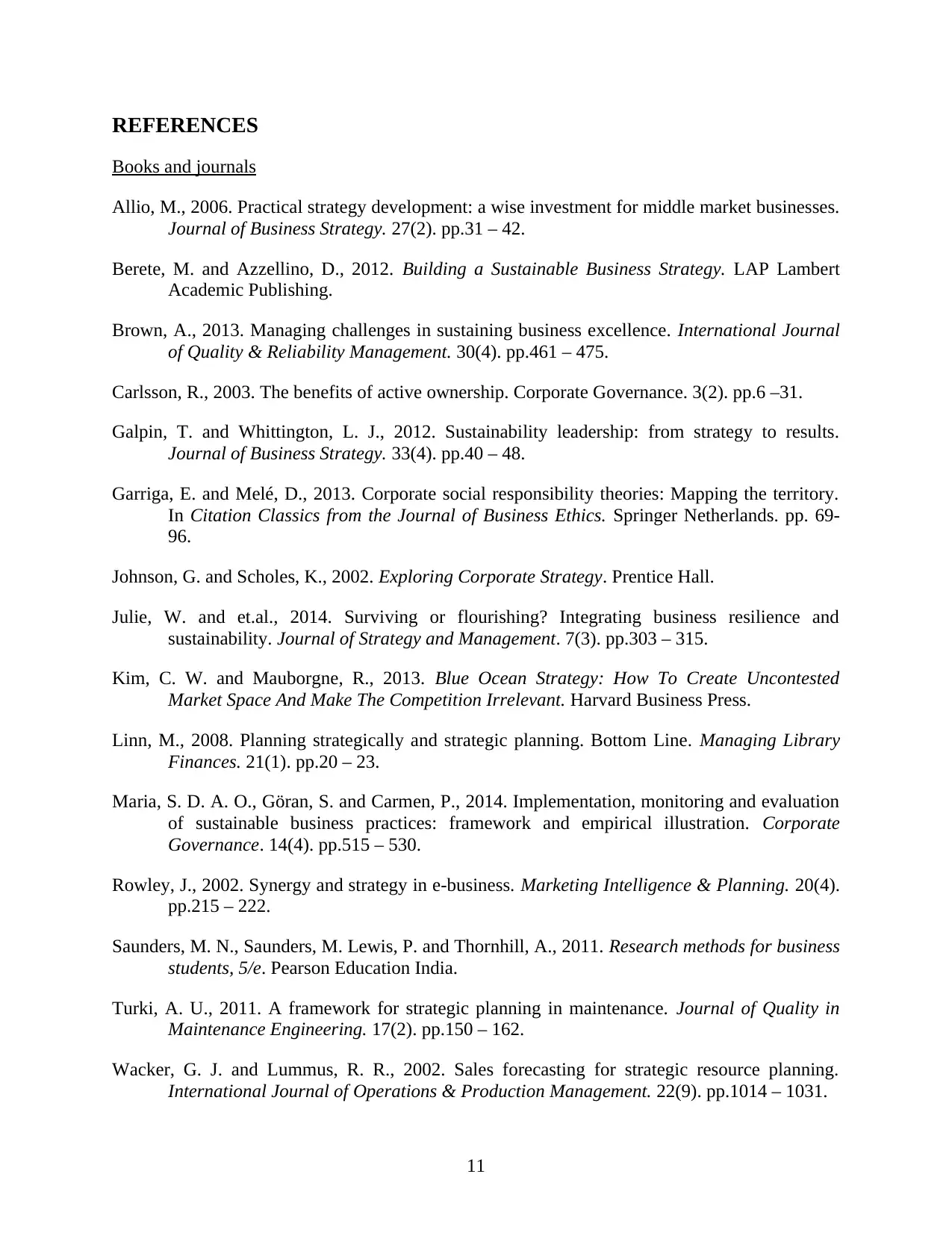
REFERENCES
Books and journals
Allio, M., 2006. Practical strategy development: a wise investment for middle market businesses.
Journal of Business Strategy. 27(2). pp.31 – 42.
Berete, M. and Azzellino, D., 2012. Building a Sustainable Business Strategy. LAP Lambert
Academic Publishing.
Brown, A., 2013. Managing challenges in sustaining business excellence. International Journal
of Quality & Reliability Management. 30(4). pp.461 – 475.
Carlsson, R., 2003. The benefits of active ownership. Corporate Governance. 3(2). pp.6 –31.
Galpin, T. and Whittington, L. J., 2012. Sustainability leadership: from strategy to results.
Journal of Business Strategy. 33(4). pp.40 – 48.
Garriga, E. and Melé, D., 2013. Corporate social responsibility theories: Mapping the territory.
In Citation Classics from the Journal of Business Ethics. Springer Netherlands. pp. 69-
96.
Johnson, G. and Scholes, K., 2002. Exploring Corporate Strategy. Prentice Hall.
Julie, W. and et.al., 2014. Surviving or flourishing? Integrating business resilience and
sustainability. Journal of Strategy and Management. 7(3). pp.303 – 315.
Kim, C. W. and Mauborgne, R., 2013. Blue Ocean Strategy: How To Create Uncontested
Market Space And Make The Competition Irrelevant. Harvard Business Press.
Linn, M., 2008. Planning strategically and strategic planning. Bottom Line. Managing Library
Finances. 21(1). pp.20 – 23.
Maria, S. D. A. O., Göran, S. and Carmen, P., 2014. Implementation, monitoring and evaluation
of sustainable business practices: framework and empirical illustration. Corporate
Governance. 14(4). pp.515 – 530.
Rowley, J., 2002. Synergy and strategy in e-business. Marketing Intelligence & Planning. 20(4).
pp.215 – 222.
Saunders, M. N., Saunders, M. Lewis, P. and Thornhill, A., 2011. Research methods for business
students, 5/e. Pearson Education India.
Turki, A. U., 2011. A framework for strategic planning in maintenance. Journal of Quality in
Maintenance Engineering. 17(2). pp.150 – 162.
Wacker, G. J. and Lummus, R. R., 2002. Sales forecasting for strategic resource planning.
International Journal of Operations & Production Management. 22(9). pp.1014 – 1031.
11
Books and journals
Allio, M., 2006. Practical strategy development: a wise investment for middle market businesses.
Journal of Business Strategy. 27(2). pp.31 – 42.
Berete, M. and Azzellino, D., 2012. Building a Sustainable Business Strategy. LAP Lambert
Academic Publishing.
Brown, A., 2013. Managing challenges in sustaining business excellence. International Journal
of Quality & Reliability Management. 30(4). pp.461 – 475.
Carlsson, R., 2003. The benefits of active ownership. Corporate Governance. 3(2). pp.6 –31.
Galpin, T. and Whittington, L. J., 2012. Sustainability leadership: from strategy to results.
Journal of Business Strategy. 33(4). pp.40 – 48.
Garriga, E. and Melé, D., 2013. Corporate social responsibility theories: Mapping the territory.
In Citation Classics from the Journal of Business Ethics. Springer Netherlands. pp. 69-
96.
Johnson, G. and Scholes, K., 2002. Exploring Corporate Strategy. Prentice Hall.
Julie, W. and et.al., 2014. Surviving or flourishing? Integrating business resilience and
sustainability. Journal of Strategy and Management. 7(3). pp.303 – 315.
Kim, C. W. and Mauborgne, R., 2013. Blue Ocean Strategy: How To Create Uncontested
Market Space And Make The Competition Irrelevant. Harvard Business Press.
Linn, M., 2008. Planning strategically and strategic planning. Bottom Line. Managing Library
Finances. 21(1). pp.20 – 23.
Maria, S. D. A. O., Göran, S. and Carmen, P., 2014. Implementation, monitoring and evaluation
of sustainable business practices: framework and empirical illustration. Corporate
Governance. 14(4). pp.515 – 530.
Rowley, J., 2002. Synergy and strategy in e-business. Marketing Intelligence & Planning. 20(4).
pp.215 – 222.
Saunders, M. N., Saunders, M. Lewis, P. and Thornhill, A., 2011. Research methods for business
students, 5/e. Pearson Education India.
Turki, A. U., 2011. A framework for strategic planning in maintenance. Journal of Quality in
Maintenance Engineering. 17(2). pp.150 – 162.
Wacker, G. J. and Lummus, R. R., 2002. Sales forecasting for strategic resource planning.
International Journal of Operations & Production Management. 22(9). pp.1014 – 1031.
11
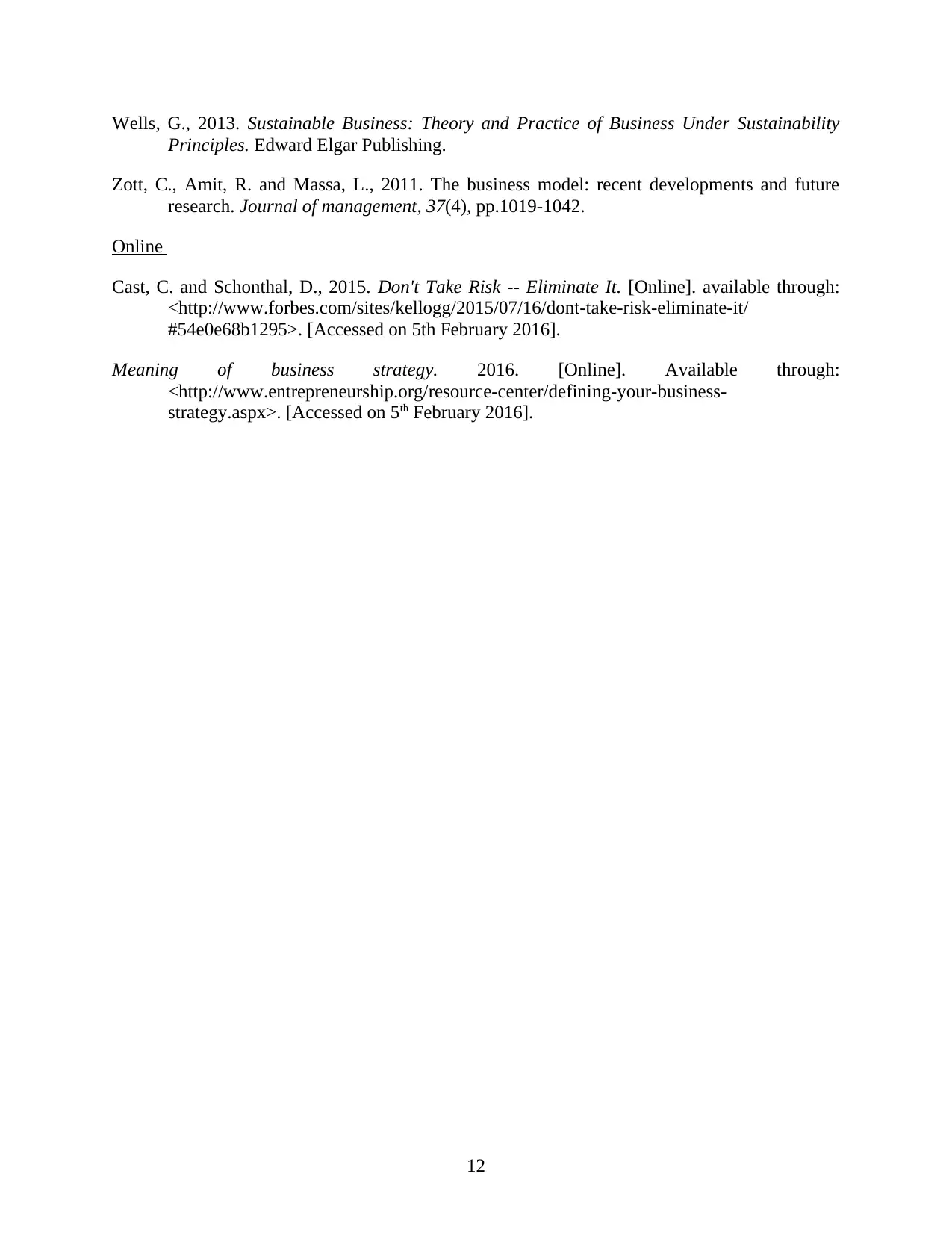
Wells, G., 2013. Sustainable Business: Theory and Practice of Business Under Sustainability
Principles. Edward Elgar Publishing.
Zott, C., Amit, R. and Massa, L., 2011. The business model: recent developments and future
research. Journal of management, 37(4), pp.1019-1042.
Online
Cast, C. and Schonthal, D., 2015. Don't Take Risk -- Eliminate It. [Online]. available through:
<http://www.forbes.com/sites/kellogg/2015/07/16/dont-take-risk-eliminate-it/
#54e0e68b1295>. [Accessed on 5th February 2016].
Meaning of business strategy. 2016. [Online]. Available through:
<http://www.entrepreneurship.org/resource-center/defining-your-business-
strategy.aspx>. [Accessed on 5th February 2016].
12
Principles. Edward Elgar Publishing.
Zott, C., Amit, R. and Massa, L., 2011. The business model: recent developments and future
research. Journal of management, 37(4), pp.1019-1042.
Online
Cast, C. and Schonthal, D., 2015. Don't Take Risk -- Eliminate It. [Online]. available through:
<http://www.forbes.com/sites/kellogg/2015/07/16/dont-take-risk-eliminate-it/
#54e0e68b1295>. [Accessed on 5th February 2016].
Meaning of business strategy. 2016. [Online]. Available through:
<http://www.entrepreneurship.org/resource-center/defining-your-business-
strategy.aspx>. [Accessed on 5th February 2016].
12
1 out of 15
Related Documents
Your All-in-One AI-Powered Toolkit for Academic Success.
+13062052269
info@desklib.com
Available 24*7 on WhatsApp / Email
![[object Object]](/_next/static/media/star-bottom.7253800d.svg)
Unlock your academic potential
© 2024 | Zucol Services PVT LTD | All rights reserved.





